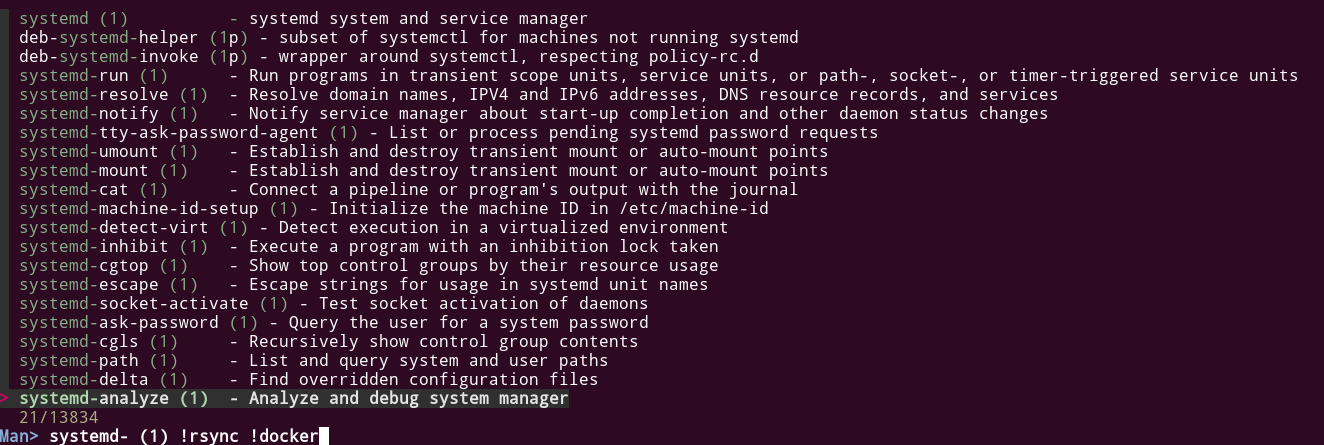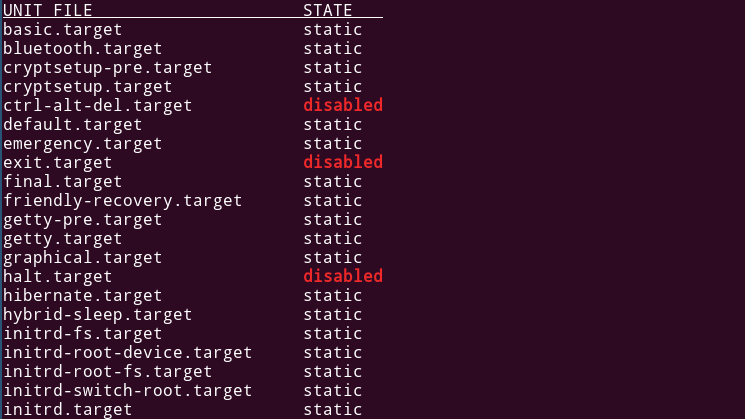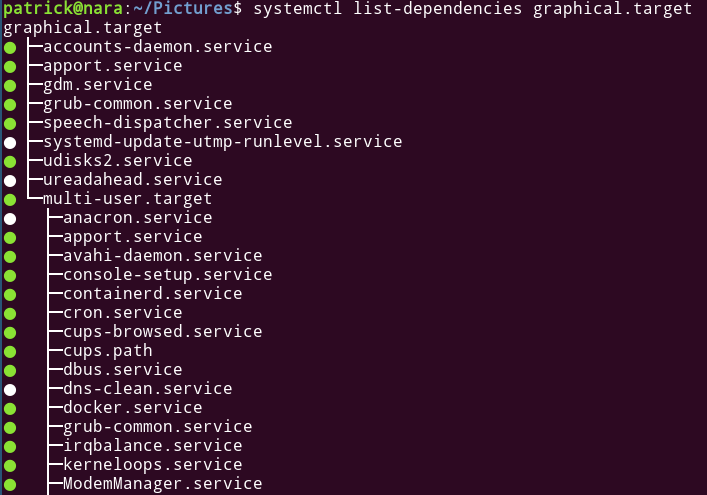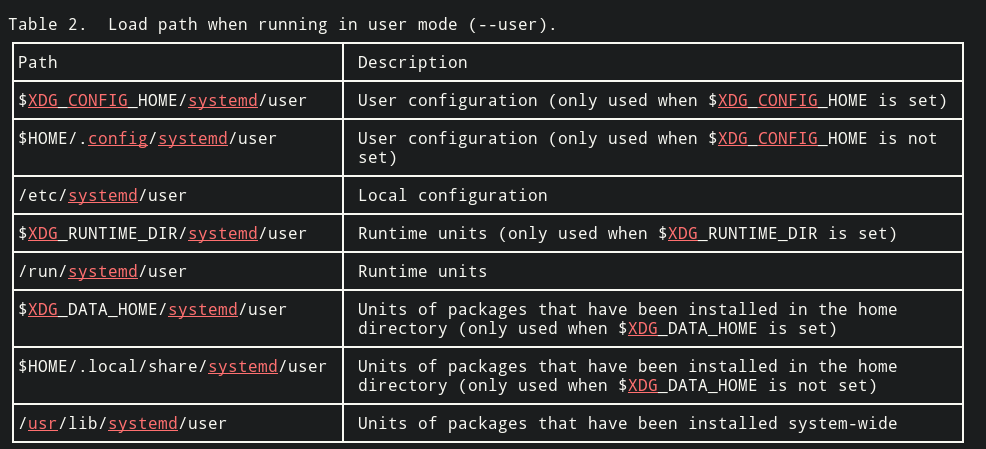Cozy Computer
Run Bash scripts on startup using systemd on Ubuntu 4209 words (17 min)
Motivation
I use a tiling window manager called i3 which mostly does away with Ubuntu’s default configurations.
One side-effect of my i3 setup is that on startup the screen resolution is always set to its native resolution which makes text way too small.
I wrote a configuration file for i3 to fix this but it either doesn’t run or seems to get overwritten by another process that also changes the screen resolution (probably X11 Window Manager).
I read that you can fix this using an ~/.xsessionrc file - but this file can also be overridden by other programs.
We can set the screen resolution automatically by running a Bash program on startup using systemd.
Background on systemd
systemd and the init process
systemd is a process and daemon manager for Linux. It’s in charge of running units which are abstractions for various startup and maintenance tasks. Manual files for systemd can be found using man systemd.
When Linux boots, systemd will start a process called init which all other ‘user-space’ (non-kernel-related) processes are spawned from.
Using an interactive process viewer like htop we can see that all processes are spawned by either init (systemd) or by kthreadd (kernel thread daemon):

These processes have Process IDs (PIDs) 1 (init/systemd) and 2 (kthreadd) and it’s implied that they are started by the kernel’s process scheduler which is not shown but could be represented by PID 0.
Although we can’t see PID 0 we can use ps (process snapshot) to see the Parent Process ID (PPID) is 0 for processes 1 (init) and 2 (kthreadd) by running ps -f 1 2:
UID PID PPID C STIME TTY TIME CMD
root 1 0 0 Mar18 ? 00:00:09 /sbin/init splash
root 2 0 0 Mar18 ? 00:00:00 [kthreadd]
The kthreadd process is in charge of communicating with the underlying hardware.
The init process is synonymous with systemd and is in charge of running higher-level programs and daemons (background processes).
systemd units
Units are the fundamental abstraction for systemd.
Units are defined in unit configuration files.
They describe various objects and processes that are used during system startup and while the system is running.
Systemd manages eleven types of units:
1. Service units - for controlling daemons and processes
2. Socket units - for managing local and network sockets
3. Target units - for grouping units or marking steps in the system state
4. Device units - for controlling system devices
5. Mount units - for controlling file system mount points
6. Automount units - for on-demand file mounting
7. Timer units - for triggering other units
8. Swap units - for memory swap partitions
9. Path units - for watching the filesystem for changes
10 .Slice units - for grouping units
11. Scope units - for managing foreign processes
We’ll run a service unit, trigger it with a timer unit, and run it at the correct spot during startup using a target unit.
systemd unit tree
Units in systemd are arranged in a tree hierarchy to determine the order they’re run in. Units can be arranged to startup up before, after, or in parallel with other units. Along the way, intermediate target units are reached which specify that a certain group of units should be run.
These target units replace RUN levels from earlier version of Linux which were used to describe what state of startup the system was in.
The runlevel command returns the last two system runlevels:
N 5
Here 5 is the current run level. From man runlevel we can see that runlevel 5 corresponds to the systemd target unit of graphical.target:

The table only shows six run levels. Because systemd uses target units, we can have as many intermediate system states as we want during startup. This is why runlevel returns N for the previous runlevel - there is no corresponding runlevel for the system state before this one because there are many more target units than there are runlevels.
Note that units can belong to the system or to the user. There are separate unit trees for both and units from one tree cannot depend on the units from the other tree.
systemd-analyze for viewing the unit tree
Section 1 of the manual (executable programs) has many command-line tools beginning with systemd-:

One is systemd-analyze - a tool for analyzing performance data for systemd, debugging systemd, and visualizing the unit tree.
systemd-analyze shows how long the last startup took.
It shows kernel time - when the machine was booting up - and userspace time - when systemd was starting up:
Startup finished in 2.918s (kernel) + 8.440s (userspace) = 11.359s
graphical.target reached after 8.427s in userspace
We can visualize all of the units that ran during the last startup and see how long each one took to initialize using systemd-analyze plot which will save an .svg plot for us. Run systemd-analyze plot > systemd-plot.svg and open the svg using xdg-open systemd-plot.svg. Part of my systemd plot is shown below:

Processes that are starting up are shown in dark red and processes that successfully started are shown in light red.
We can see that systemd does not start until after the kernel finishes loading. This makes sense because systemd is started by the kernel.
During startup the system reaches various states marked by target units. The final three target units are network-online.target, multi-user.target, and graphical.target:

Notice how network-online.target is only achieved after NetworkManager-wait-online.service finishes activating. This is an excellent example of using target units to mark system state. The network-online.target is only activated once the system is connected to the network. This target lets network-dependent services like docker.service know they can startup.
It appears that graphical.target is systemd’s final system state on startup because it is the final target unit in the graph.
systemctl for viewing and managing systemd units
The systemctl (system control) command-line tool can be used to manage systemd units. It uses the syntax systemctl [action] [unitName]. Some useful commands:
systemctl start unitNameto start (activate) a system unit to run the unit once or start a daemonsystemctl stop unitNameto stop (deactivate) a running unit or daemonsystemctl status unitNameto check whether a unit is running and to view the most recent log data from the unitsystemctl enable unitNameto make a unit start on startup and setup symbolic links for systemd to function correctlysystemctl disable unitNameto prevent a unit starting on startup and remove symbolic links for that unitsystemctl reenable unitNameis equivalent ofdisableand thenenable
View the default target unit that systemd tries to reach during startup with systemctl get-default:
graphical.target
This confirms the hypothesis above that graphical.target is the final system state during startup.
Running systemctl by itself shows all active systemd units.
We can view all installed units on the system (whether active or inactive) with systemctl list-unit-files.
You can also filter the list of units by one of the eleven types with the --type flag. Let’s view all target units on the system using systemctl list-unit-files --type=target (only the first few are displayed):

You can view the dependency tree for a unit.
Since we know that graphical.target is the final system state, we expect that it depends on all other units.
View all units that depend on graphical.target - all of the units systemd will activate during startup - using systemctl list-dependencies graphical.target (only first few are displayed):

Deeper nodes in the tree generally represent programs that are run earlier in the startup sequence.
Viewing user units
All systemctl commands are for system units by default.
But there are also user units which belong to their own unit tree. To view information for user units you can run most systemctl commands with the --user flag.
systemd unit files
Units are described in configuration files named following the convention unitName.unitType. So in graphical.target, the unit named graphical has unit type target.
From the manual (man systemd.unit), system unit files are located in the following directories:

User unit files are located in these directories:

For both system and user unit files, you are free to save them anywhere, as long as they are symbolic linked back into one of the directories above where systemd looks for unit files.
You can open unit files directly or have systemctl print them using systemctl cat unitName. Here’s the contents of graphical.target:
# /lib/systemd/system/graphical.target
# SPDX-License-Identifier: LGPL-2.1+
#
# This file is part of systemd.
#
# systemd is free software; you can redistribute it and/or modify it
# under the terms of the GNU Lesser General Public License as published by
# the Free Software Foundation; either version 2.1 of the License, or
# (at your option) any later version.
[Unit]
Description=Graphical Interface
Documentation=man:systemd.special(7)
Requires=multi-user.target
Wants=display-manager.service
Conflicts=rescue.service rescue.target
After=multi-user.target rescue.service rescue.target display-manager.service
AllowIsolate=yes
Unit files are groups of key=value pairs broken up into sections. Typical sections include:
[Unit]for describing generic information about the unit including its dependencies[Install]for describing how to set up the unit when it is enabled usingsystemctl enable unitName- A section specific to the type of unit. For instance,
[Service]for.servicefiles,[Timer]for.timerfiles,[Socket]for.socketfiles, etc.
Note that target unit files do not have a special [Target] section because target units are only intended to group other units or act as milestones for system states.
Building a systemd unit for fixing screen resolution
Recall that I’d like to run a bash script during startup that fixes my screen resolution.
The service unit type - for controlling daemons and processes - seems appropriate for this.
Learn more about service unit types from the manual (man systemd.service).
This service can be a user unit rather than a system unit because I want the unit to run when I log in rather than when the system boots.
We’ll save the unit in ~/.config/systemd/user/ from above.
fixresolution.sh
The bash script for setting my screen resolution:
#! /usr/bin/env bash
set -Ceuo pipefail
xrandr --output eDP1 --mode 1920x1080
The line set -Ceuo pipefail is just for handling errors.
The script uses xrandr - a command-line interface for setting screen size, orientation, and resolution - to set my screen resolution.
Running xrandr on its own will show you what screens your system recognizes, their current and available resolutions, and whether they are connected or not. Each screen is named something like eDP1, DP1, HDMI1, HDMI2, etc.
Replace the --output eDP1 with the name of your monitor and --mode 1920x1080 with your desired resolution.
Save fixresolution.sh somewhere in your home directory and make it executable with chmod u+x fixresolution.sh.
Test the script by changing your resolution to something non-ideal like xrandr --output yourMonitorName --mode 1024x768 and then running ./fixresolution.sh to set it back to the desired resolution.
fixresolution.service
We’ll build a service unit to run fixresolution.sh on startup.
Paste the following into ~/.config/systemd/user/fixresolution.service, updating ExecStart= to the path where you saved fixresolution.sh:
[Unit]
Description=Fix startup screen resolution
After=default.target
[Service]
Type=idle
RemainAfterExit=yes
ExecStart=/home/patrick/recurse/bash-scripts/systemd-fix-resolution/fixresolution.sh
[Install]
WantedBy=default.target
Running systemctl --user get-default shows that the final target system state for user units is default.target.
We’ll run our script as that target is reached. Hopefully most startup tasks have been completed by then and won’t overwrite our resolution settings again.
Unit
Available settings for [Unit] (generic unit settings) are available in man systemd.unit. The ones I use:
Description=Fix startup screen resolutionis a short description of the unit for UI and logs to displayAfter=default.targetwill run this unit after the unitdefault.targetis reached.
Service
Service units can have types:
simpleservices expect to run one process (systemctlwill assume that process is a daemon and keep track of it)forkingservices expect that a child process is created (systemctlwill assume the child process is a daemon and keep track of it)oneshotservices expect the process to run once and then close (systemctlassumes no daemons are created but still tracks the process)idleservices are likesimplebut don’t run until all active processes are complete (or after 5 seconds, whichever is earlier)
The idle type seems appropriate so that it runs after everything else.
ExecStart=path/to/your/program tells your service what program to run.
Available settings for [Service] (service specific settings) are available in man systemd.service. The ones I use are:
Type=idlesets type toidleRemainAfterExit=yesmarks my service asactiveeven after the script has finished running. We can usesystemctlto examine the process even after it has finished running.ExecStart=/home/patrick/recurse/bash-scripts/systemd-fix-resolution/fixresolution.shhas the path to my bash script
Install
All units may have an [Install] section for setting up the unit using systemctl enable. This section tells where the unit will be placed in the unit tree:
WantedBy=default.targetmeans that this service will start whendefault.targetis started (it will be made a direct child ofdefault.target).
Unit dependencies
Units can be made to depend upon one another in complex ways.
Some common ways to state dependencies and run orders for our unit (the unit we are writing the configuration file for):
Before=someUnitfinishes running our unit before runningsomeUnitAfter=someUnitruns our unit after finishing runningsomeUnitWants=someUnitrunssomeUnitwhen our unit is run (they can be run at the same time)Requires=someUnitruns our unit only ifsomeUnitcan be sucessfully started
Running fixresolution.service
Our service is now saved at ~/.config/systemd/user/fixresolution.service.
Run systemctl --user daemon-reload to tell systemd to rescan for new unit files.
Confirm that systemctl found the new service using systemctl --user status fixresolution;

Change your screen resolution again using xrandr --output yourMonitorName --mode 1024x768 and run systemctl --user start fixresolution.
If the service runs successfully your resolution should be reset to the resolution set in fixresolution.service.
systemctl enable
Units can be set to run automatically on startup using systemctl enable unitName.
systemctl enable does two things:
- it creates directories with names that describe our dependencies by reading from the
[Install]section - it places a
symbolic linkrepresenting our service inside those directories
This directory structure locates our unit in the unit tree that systemd uses to determine run order on startup.
Running systemctl --user enable fixresolution will create a directory describing the dependency for fixresolution:
Created symlink /home/patrick/.config/systemd/user/default.target.wants/fixresolution.service → /home/patrick/.config/systemd/user/fixresolution.service
The default.target.wants directory means that our service will be run when default.target is started.
We can see that fixresolution is successfully placed in the unit tree by running systemctl --user list-dependencies default.target:

The service should now run on startup (except that it’s not right yet!).
Journalctl and examining systemd logs
I restarted my computer after enabling the service and found that my screen resolution had not been updated correctly.
Systemd keeps log files related to running units in the systemd journal.
You can examine the systemd journal using journalctl (journal control). Running journalctl on it’s own shows many thousands of lines of journal. And it only shows the logs for the system units.
Examine the last 3000 lines of the user units journal using journalctl --user -e -n 3000 (where -e means show the end and -n is the number of lines to show):
Mar 20 13:39:05 nara systemd[1757]: Started Fix startup screen resolution.
Mar 20 13:39:05 nara systemd[1757]: Startup finished in 36ms.
Mar 20 13:39:05 nara systemd[1757]: fixresolution.service: Main process exited, code=exited, status=1/FAILURE
Mar 20 13:39:05 nara systemd[1757]: fixresolution.service: Failed with result 'exit-code'.
...
Mar 20 13:39:05 nara /usr/lib/gdm3/gdm-x-session[1778]: X.Org X Server 1.20.1
Mar 20 13:39:05 nara /usr/lib/gdm3/gdm-x-session[1778]: X Protocol Version 11, Revision 0
The fixresolution service encountered an error: Can't open display.
At the bottom of the log we can see that X Server is starting up after our script runs. The X Server is a display server run by X11. It’s in charge of the GUI window system for my machine.
It seems reasonable that my script would fail if it runs before X Server.
timer units
The fixresolution service is not being run at the correct time.
One solution is to run our service using a timer unit - a unit that waits some time and then activates another unit.
Timer units have a [Timer] section described in man service.timer. A few settings I use:
Unit=unitNamethe unit to activate when the timer is upOnActiveSec=targetTimeactivates the unit after the timer has been active for some timeOnBootSec=targetTimeactivates the unit some time after the machine turns onOnStartupSec=targetTimeactivates the unit some time aftersystemdhas started up
Let’s create ~/.config/systemd/user/fixresolution.timer that will activate fixresolution.service ten seconds after startup:
[Unit]
Description=Runs the fixresolution.service 10 seconds after startup
[Timer]
OnStartupSec=10
Unit=fixresolution.service
[Install]
WantedBy=default.target
Tell systemd to look for your new unit using systemctl --user daemon-reload.
We can test the timer by changing our resolution with xrandr --output eDP1 --mode 1024x768 and running the timer:
systemctl --user start fixresolution.timer
Because it is more than 10 seconds after startup, it should instantly reset the screen resolution.
Enable the timer to run on boot using systemctl --user enable fixresolution.timer and verify that it has been placed in the unit tree using systemctl --user list-dependencies default.target.
Testing the timer unit on startup
After I restart my machine it takes a long time but the timer does finally reset the screen resolution.
From journalctl --user -e -n 3000:
Mar 20 13:39:05 nara systemd[1757]: Started Runs the fixresolution.service 10 seconds after startup.
Mar 20 13:39:05 nara systemd[1757]: Reached target Timers.
...
Mar 20 13:39:42 nara systemd[1757]: Started Fix startup screen resolution.
Mar 20 13:39:42 nara /usr/lib/gdm3/gdm-x-session[1778]: (II) intel(0): resizing framebuffer to 1920x1080
Mar 20 13:39:42 nara /usr/lib/gdm3/gdm-x-session[1778]: (II) intel(0): switch to mode 1920x1080@60.0 on eDP1 using pipe 0, position (0, 0), rotation normal, reflection none
The timer started at 13:39:05 but the service didn’t run until 13:39:42. It takes the service 37 seconds to run!
This is way too long. Let’s try a more brute force approach.
Disable the timer using systemctl --user disable fixresolution.timer.
Running a service multiple times on startup
To change the screen resolution as quickly as possible, we’d like to just keep trying to run fixresolution.service until it doesn’t return an error.
You can use Restart=on-failure in the [Service] section to restart the service whenever it fails. By default it will wait 100ms between runs.
But how many times should it run before giving up? We don’t want it to pollute our systemd logs if it never runs successfully.
Use StartLimitBurst=30 and StartLimitIntervalSec=10 m to stop attempting to run the service if it runs more than 30 times in 10 minutes.
The updated unit file at ~/.config/systemd/user/fixresolution.service:
[Unit]
Description=Fix startup screen resolution
After=default.target
StartLimitBurst=30
StartLimitIntervalSec=10 m
[Service]
Restart=on-failure
Type=idle
RemainAfterExit=yes
ExecStart=/home/patrick/recurse/bash-scripts/systemd-fix-resolution/fixresolution.sh
[Install]
WantedBy=default.target
Run systemctl --user daemon-reload so that systemd finds our updated unit file.
Restart the computer and it will start with the correct screen resolution!
We can look in journalctl --user -e -n 3000 to see how many times the service restarted before running successfully:
Mar 20 15:22:21 nara systemd[1869]: Reached target Default.
Mar 20 15:22:21 nara systemd[1869]: Started Fix startup screen resolution.
Mar 20 15:22:21 nara systemd[1869]: Startup finished in 39ms.
Mar 20 15:22:21 nara systemd[1869]: fixresolution.service: Main process exited, code=exited, status=1/FAILURE
Mar 20 15:22:21 nara systemd[1869]: fixresolution.service: Failed with result 'exit-code'.
...
Mar 20 15:22:22 nara systemd[1869]: fixresolution.service: Service hold-off time over, scheduling restart.
Mar 20 15:22:22 nara systemd[1869]: fixresolution.service: Scheduled restart job, restart counter is at 1.
Mar 20 15:22:22 nara systemd[1869]: Stopped Fix startup screen resolution.
Mar 20 15:22:22 nara systemd[1869]: Started Fix startup screen resolution.
...
Mar 20 15:22:22 nara systemd[1869]: fixresolution.service: Service hold-off time over, scheduling restart.
Mar 20 15:22:22 nara systemd[1869]: fixresolution.service: Scheduled restart job, restart counter is at 3.
Mar 20 15:22:22 nara systemd[1869]: Stopped Fix startup screen resolution.
Mar 20 15:22:22 nara systemd[1869]: Started Fix startup screen resolution.
Mar 20 15:22:22 nara /usr/lib/gdm3/gdm-x-session[1890]: (II) intel(0): resizing framebuffer to 1920x1080
Mar 20 15:22:22 nara /usr/lib/gdm3/gdm-x-session[1890]: (II) intel(0): switch to mode 1920x1080@60.0 on eDP1 using pipe 0, position (0, 0), rotation normal, reflection none
The fixresolution service had to restart three times before successfully updating my screen resolution. The resolution is updated almost immediately - less than one second after logging in.
Summary
- We can use
systemdunits to perform various tasks. - Units can belong to the
systemor to theuser. - Units are described in
unit files. - Units can be managed with
systemctl. - Units can run during startup using
systemctl enable. Target unitsdescribe various system states and help group units togetherService unitsdescribe processes and daemonsTimer unitscan be used to trigger other unitsjournalctlis used to view systemd logs


 <---- Want to become a better programmer?
<---- Want to become a better programmer?